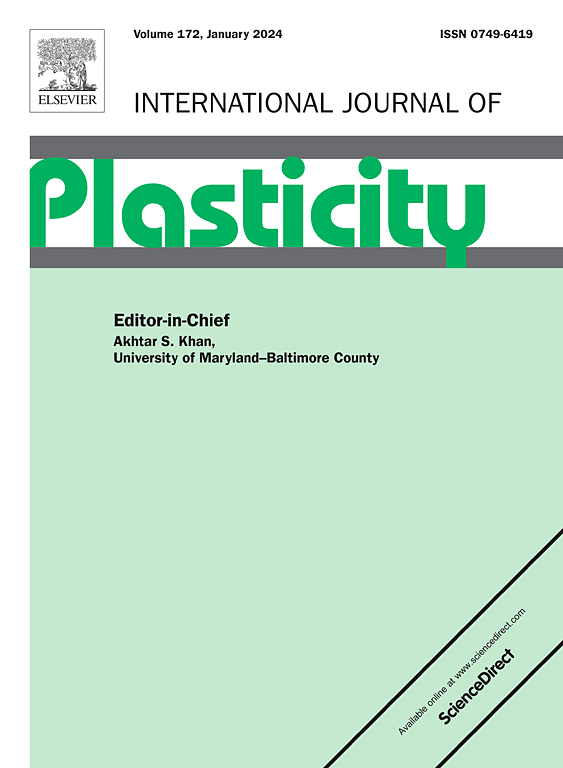Atomic mechanisms for the fracture of AlMo0.5NbTa0.5TiZr refractory high entropy superalloy
IF 9.4
1区 材料科学
Q1 ENGINEERING, MECHANICAL
引用次数: 0
Abstract
Refractory high entropy superalloys (RHESs), known for their excellent high temperature performance, exhibit promising characteristics but are challenged by significant brittleness. Efforts to enhance plasticity through microstructure regulation have achieved only limited success, largely due to the unclear underlying fracture mechanisms of the superstructure. In this study, we systematically investigate the fracture mechanisms of the AlMo0.5NbTa0.5TiZr RHES from microscopic to electronic scales. Interestingly, both experimental and simulation results reveal that the ordered B2 phase demonstrates non-negligible plastic deformation capabilities during fracture, including deformation twinning and amorphization. Despite this, the fracture resistance of the B2 phase is lower compared to the A2/B2 interface and disordered A2 phase, even though the A2 phase shows less twinning and amorphization. Ab initio molecular dynamics simulations, combined with electronic behavior analysis, indicate that bonds involving Al and Zr in the B2 phase often exist in an anti-bonding state, making them more prone to breaking under load. This study provides deeper insights into the fracture mechanisms of the A2/B2 superstructure and its constituent phases at both atomic and electronic levels, offering a systematic approach to improving the fracture properties of such RHESs.
AlMo0.5NbTa0.5TiZr 难熔高熵超合金断裂的原子机制
难熔高熵超合金(RHES)以其优异的高温性能而闻名,具有良好的特性,但也面临着明显脆性的挑战。通过调节微观结构来提高塑性的努力只取得了有限的成功,这主要是由于上层结构的基本断裂机制尚不明确。在本研究中,我们从微观到电子尺度系统地研究了 AlMo0.5NbTa0.5TiZr RHES 的断裂机制。有趣的是,实验和模拟结果均显示,有序的 B2 相在断裂过程中表现出不可忽视的塑性变形能力,包括变形孪晶和非晶化。尽管如此,与 A2/B2 界面和无序的 A2 相相比,B2 相的断裂抗力较低,尽管 A2 相显示出较少的孪晶和非晶化。Ab initio 分子动力学模拟结合电子行为分析表明,B2 相中涉及 Al 和 Zr 的键通常处于反键状态,因此在载荷作用下更容易断裂。这项研究从原子和电子层面深入揭示了 A2/B2 超结构及其组成相的断裂机制,为改善此类 RHES 的断裂性能提供了系统方法。
本文章由计算机程序翻译,如有差异,请以英文原文为准。
求助全文
约1分钟内获得全文
求助全文
来源期刊

International Journal of Plasticity
工程技术-材料科学:综合
CiteScore
15.30
自引率
26.50%
发文量
256
审稿时长
46 days
期刊介绍:
International Journal of Plasticity aims to present original research encompassing all facets of plastic deformation, damage, and fracture behavior in both isotropic and anisotropic solids. This includes exploring the thermodynamics of plasticity and fracture, continuum theory, and macroscopic as well as microscopic phenomena.
Topics of interest span the plastic behavior of single crystals and polycrystalline metals, ceramics, rocks, soils, composites, nanocrystalline and microelectronics materials, shape memory alloys, ferroelectric ceramics, thin films, and polymers. Additionally, the journal covers plasticity aspects of failure and fracture mechanics. Contributions involving significant experimental, numerical, or theoretical advancements that enhance the understanding of the plastic behavior of solids are particularly valued. Papers addressing the modeling of finite nonlinear elastic deformation, bearing similarities to the modeling of plastic deformation, are also welcomed.
 求助内容:
求助内容: 应助结果提醒方式:
应助结果提醒方式:


